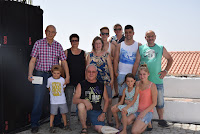(...)
Soon after the last handing out of the guidons and the return of the statue of Saint Anthony to the church we gathered outside the Churchyard with the other members of the family I was staying at. I soon noticed that families in Alentejo have a rather strong family bond and often do things together, especially during the Summer holiday period, which is something most people who live in the cities don't relish any more.
Because we had been invited over for lunch Misi, the children and I decided to venture into some of the side pathways and narrow streets along the temporarily dry river that runs through the village. So as to fully understand what life in the village used to be Misi, who was born and brought up in the village shared some of her incredible childhood stories with me as she revisited some of the places on the way.




Once I got back "home" after lunch I had to lie down for a while. The heat was almost unbearable and the idea of having to follow the procession through the village streets some time later was beginning to worry me because it was more than obvious that the heat would most probably interfere with my willingness to do so.

The Church bells announced the event and soon Misi, the children and I took to the streets in some of our best clothes, as in accordance with the local "rituals". Men walked behind the brass band musicians, whilst the women and children took their position in the procession either right behind the statues of the Saints and the guidons or on the sides. I would later find out (after having accidently perverted the course of things) that men and women are not supposed to mingle.
Wide open doors and the best bedcovers hanging from the open windows or balconies are included in the list of rituals to be followed and in that respect not much different from some rituals which used to be followed over the Easter period in some of the Northern cities of Portugal, at least some fifty years ago.









The Church is the "heart" of the festivities once every event therewith associated seemed to either start or end at its yard or even inside it. As people chanted and prayed together in the church I saw quite a few women getting emotional, which didn't surprise me once the whole sequencing led to a natural crescendo.


















No comments:
Post a Comment